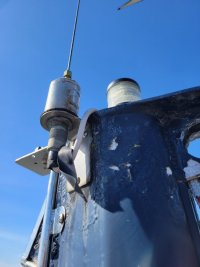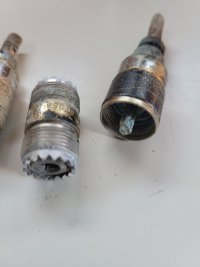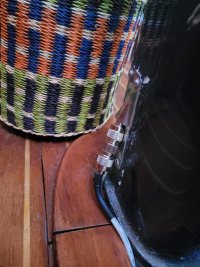Has anyone successfully replaced a VHF coax in their Kenyon mast wiring channel?
I've been chasing some VHF issues since installing the Vesper Cortex and now I'm at the point where I think the coax should be replaced. I've replaced all the connectors, but the center conductor has some corrosion that I'm not able to cut out because there's not enough slack.
Before:


After (I had to replace the section going back to the nav desk after I took this picture because I noticed the crimp wasn't correct after looking at this pic)

I thought it would be somewhat straight forward because I was able to pull the existing RG-59 up the mast to gain slack when I replaced the antenna and put a new PL-259 connector on the end, but now I'm second guessing that assumption.
Yesterday, I put an endoscope in the wiring exit hole at the base of the mast and realized the existing cable is run down the wiring channel behind the sail track. It exits the channel a few inches above the base of the mast and comes out on the port side of the mast. I'm not sure what's happening at the top. All I can see is is enters the mast at the top of the masthead, but I'm not sure how it gets from there to the wiring channel. There wasn't that much resistance, but I'm planning on replacing the RG-59 with RG-213. Any advice would be greatly appreciated!
I've been chasing some VHF issues since installing the Vesper Cortex and now I'm at the point where I think the coax should be replaced. I've replaced all the connectors, but the center conductor has some corrosion that I'm not able to cut out because there's not enough slack.
Before:


After (I had to replace the section going back to the nav desk after I took this picture because I noticed the crimp wasn't correct after looking at this pic)

I thought it would be somewhat straight forward because I was able to pull the existing RG-59 up the mast to gain slack when I replaced the antenna and put a new PL-259 connector on the end, but now I'm second guessing that assumption.
Yesterday, I put an endoscope in the wiring exit hole at the base of the mast and realized the existing cable is run down the wiring channel behind the sail track. It exits the channel a few inches above the base of the mast and comes out on the port side of the mast. I'm not sure what's happening at the top. All I can see is is enters the mast at the top of the masthead, but I'm not sure how it gets from there to the wiring channel. There wasn't that much resistance, but I'm planning on replacing the RG-59 with RG-213. Any advice would be greatly appreciated!
